 |
|
| 天藍石(Lazulite) | |
| 0.57ct 4.9x4.9mm | 0.42ct 7.1x4.5mm |
| Laila Mtn, Pakistan | Brazil |
天藍石
(Lazulite)
 |
|
| 天藍石(Lazulite) | |
| 0.57ct 4.9x4.9mm | 0.42ct 7.1x4.5mm |
| Laila Mtn, Pakistan | Brazil |
| 化学組成 (Composition) |
結晶系 (Crystal System) |
結晶形 (Crystal Form) |
モース硬度 (Hardness) |
比重 (Density) |
屈折率 (Refractive Index) |
| (Mg,Fe)Al2(PO4)2(OH)2 | 単斜晶系 (Monoclinic) |
 |
5½ - 6 | 3.1-4 | 1.61−64 |
名前と産状(Name and Occurence)
同じ色合いのラピスラズリ (青金石:Lazurite) や藍銅鉱 (Azurite) と同様にペルシア語で青を意味する ”lazaward” に因み命名されました。
色合いと綴りとが似ていることから専門家の資料や自然史博物館の説明にもラピスラズリと混同されている例を見かけます。
私自身、初めて青く透明なラジュライトのルースを見た時はラピスラズリの透明な結晶が出現したかと思わず興奮したほど。
天藍石は接触変成作用を受けた石英脈,とりわけ燐酸塩型の花崗岩ペグマタイトや、造山作用に伴う山岳性の熱水鉱脈に生成する鉱物です。
したがってアルプス、ヒマラヤ、世界各地のペグマタイトに団塊状で発見されますが産地、量共に少ない鉱物です。
したがって結晶標本、カットされたルース等を市場で見かけることは滅多にありません。
しかし小さいながらブラジル産の輝くような青いカット石は同じく稀産でごく小さなルースしか採れない藍方石(アウイン)と並び、数ある宝石の中で最も印象に残る色と言っても過言ではありません。
Hydrothermal in quartz veins and granitic pegmatites, where it is formed by decomposition of primary phosphates. Found asscociated with high grade metamorphic silicate minerals such as the kyanite-andalusite-sillimanite group, quartz, muscovite and garnet. Both localities and production of lazulite quite are quite limited, and spcimens showing clear crystal shapes are rare.
Faceted lazulite from Brazil is, although extremely rare and small (no bigger than 0.5ct), as well as haüyn, one of the most spectacular blue color among all gemstones.
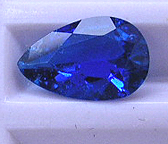 |
 |
 |
|
| 天藍石(Lazulite) 0.42ct 7.1x4.5mm Brazil |
記録的な大きさの天藍石ルース 5.85ct 10.60x10.10x6.12mm An unusual large lazulite |
||
写真左のルースは恐らくバイア州のペグマタイト産と思われます。
ややインクルージョンが目立ちますが、一般に結晶の結合が弱い燐酸塩鉱物には良くあることです。
それを補って余りある大き目の0.42カラットの大きさと輝くような明るい青の色合いとが見事です。
右の写真のルースも恐らくブラジル産と思われます。
余り魅力的とは言えない沈んだ色合いは橙色の背景も含めて、写真の色再現性に疑問があり、あくまでも参考です。
Moderately included 0.42ct stone is from Brasil, probably from pegmatite in Bahia State. Phosphate minerals are often heavily included, due to weak atomic bond. Relatively large size for faceted lazulite and bright blue color compensate enough the inclusion. Record making 5.85 stone made a sensation. The real color of this stone is, including orage back color, is a question.
天藍石の発色(Coloring mechanism of lazulite)
そっくりの色合いの藍方石 (アウイン) の発色は硫黄の電荷移動によるものですが、天藍石の場合は二価と三価の鉄イオンの電子とが酸素を介在して移動する際に赤から緑に至る低い波長の光を吸収するために残った青が見える、電荷移動 (Fe2+ - O - Fe3+) という仕組みが原因です。
最近パキスタンから発見された天藍石は黄色-黄緑-緑-青緑と広範な色合いを示します。
恐らく不純物として含まれる二価と三価の鉄イオンが不安定なために O2- » Fe3+ の電荷移動、更に三価の鉄イオンの八面体配位等,その他の発色の仕組みが組み合わせが強く影響していると考えられます。
同様な発色例はサファイア、藍晶石 (カイアナイト)、緑柱石等広範に起こります。
ただし天藍石は結晶軸の方向により青-青緑-黄色の多色性を示す鉱物となっています。
もっともブラジル産の青い石は何処から見ても青にしか見えませんが、パキスタン産の場合は多色性が強く現れた例でしょう。
Intrinsically, lazulite is trichroic in blue(often very dark), greenish blue, and pale straw yellow, although it is hardly visible in Brazilian stone. While similar bright blue of haüyn is colored by S3- chargetransfer, lazulite is colored by Fe2+ - O - Fe3+ charge transfer. The recent discovery of yellow-yellowish green-green - greenish blue luzulite from Pakistan seems to colored be with additional O2-» Fe3+ plus Fe3+ octahedral coordination. Such blue to green coloration is commonly seen such as sapphyre, kyanite and beryls, etc. etc.
天藍石の主な産地(Lazulite localities)
 |
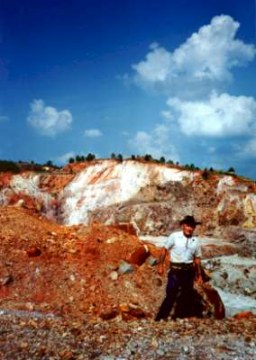 |
 |
 |
||
| 鉱山での採集光景 Mainpit collecting |
天藍石を含む団塊 Busting boulders for lazulite crystals |
石英中の天藍石結晶
27x23mm 最大の結晶 7mm Lazulite crystals in quartz |
| Graves Mountain, Georgia, U.S.A. | ||
淡紫色の燐灰石上の
天藍石結晶 1.5cm と菱鉄鉱
Lazulite crystal with siderite
and pale purple fluoapatite石英中の天藍石
Lazulite in quartz石英中の天藍石 10x8mm
Lazulite nodule in quartziteRapid Creek, Yukon Territory
Northern CanadaMitra, Slovak Republic Pizo Canciano, Val Malenco, Italia
ヨーロッパ・アルプス(European Alps)
天覧石はヨーロッパ・アルプスの熱水による変成作用を受けた石英脈中に団塊となって発見されます。
今は絶産となっていますがスイスのツェルマットでロープウェイの工事中に天藍石が発見されました。
同じアルプスのイタリア側、ヴァル・マレンコでも写真のように天藍石が報告されています。
しかし結晶形を見せるものは極めて稀です。
Lazulite are discovered as nodules in the hydrothermal vein of European Alps. A half century ago, at Zermatt, Switzerland, luzulite nodule was discovered while working for the ropeway construction. In the Italian Alps of Val Malenco, a small quantity of lazulite was reported.
グレイヴス山 (Graves Mountain, Georgia, U.S.A.)
写真のアメリカ・ジョージア州のグレイヴ山はかつて藍晶石の鉱山でした。
1963年に陶磁器や耐熱セラミック材料として採掘が始まり、一時はアメリカでの藍晶石生産の半数を占めるほどの産出があったとのこと。
その他に金紅石、虹色の赤鉄鉱、青い水晶等と共に最大で2cmと不透明ながら美しい天藍石の結晶を産します。
鉱山は現在では4月と10月に各3日間一般のコレクターに公開されています。
ゴルフで名高いオーガスタの北西60km程の地点にあり、Google Map で露天掘り鉱山が衛星写真にはっきりと写って見えます。
凄い時代になったものです。
Graves Mountain mine opened in 1961 mainly for kyanite mining for heat-resistant ceramic and porcelains and once produced the half of entire American production. Today, mine is opned each three days in April and October for mineral collectors.
Small and opaque but nice blue lazulite crystals are discovered together with iridescent hematite, spectacular rutile crystal and blue quartz etc.
カナダ北極圏・ユーコン河流域(Rapid Creek, Yukon Territory, Northern Danada)
またカナダの北極圏に近いユーコン河の支流ラピッド・クリーク流域から見事な天藍石の結晶が大量に発見されています。
1950年代末に始まった石油と天然ガス探鉱を契機に1970年代初めにこの地域に豊穣な燐酸塩鉱脈が発見されたのです。
とりわけ天藍石は世界の如何なる産地をも質、量共に凌駕する素晴らしい結晶を産します。
しかし色が濃すぎて宝石としてカットには向きません。
In the early 1970's a remarkable deposits of phosphate minerals was discovered in the Rapid Creek area of the northern Yukon Territory, Canada, while exploring for gas and oil, which operation started in 1959. Of all the species found in the Rapid Creek area, certainly the one that has received the most attention is lazulite. No other locality in the world has produced specimens of comparable quality and quantity. Fine crystals of Yukon territory is however, too dark and opaque to cut as gemstone.
ブラジルのペグマタイト(Brazilian Pegmatites)
宝石質の天藍石を産するのはブラジルのミナス・ジェライスからバイア州に延びるエスピニャーソ山脈中の何ヶ所かのペグマタイトです。
とりわけバイア州のジアマンチナが主産地です。
とは言え宝石質の天藍石は透明だがひどく融食された結晶の一部から普通は0.5カラット程度の小さなルースが稀に得られるだけです。
1993年に報告された写真の大きなルースはインクルージョンが多く色も美しいものではありませんが、しかし天藍石のルースとしては記録的な大きさとして話題となりました。
We know of only one good-sized facet-quality piece, a fairly large, etched, Brazilian crystal with spectacular transparency and trichroism. An occasional small, gemmy fragments has been cut, but nothing else has been found capable of yielding anything larger than a carat or two(may be as many as five), recovered from pegmatites in Espinhaço range, stretching between Minas Gerais and Bahia. Diamantina pegmatites are the most representative locality.
数ある宝石の中で、藍方石と共に際立って美しい天藍石がごく稀に、しかも極めて小さな石しか採れないのは残念なことです。
F.ポー博士はラピダリー・ジャーナル誌の1994年12月号で、もし透明な宝石質の天藍石が発見されるとすれば、それはヒマラヤのペグマタイトであろうと予期しています。
It is indeed a regret that gemstones with spectacular color like, lazulite and haüyn are so scarece and yields only a tiny pieces. Dr. Frederick Pough describes in Lapidary Journal December 1994, "The likelyhood is that if we are ever to find a gemmy, i.e., transparent deposit, it will be pegmatic, .... my prediction is, for the ultimate occurence, look to the mountains (the Himalayas, in particular)
パキスタンの天藍石(Lazulite from Pakistan)
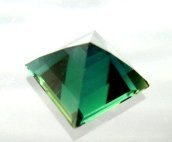 |
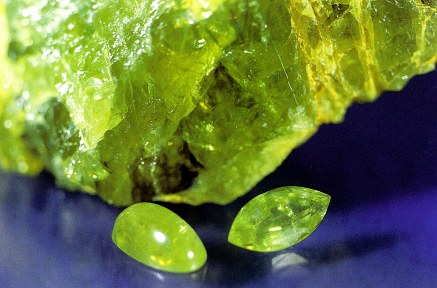 |
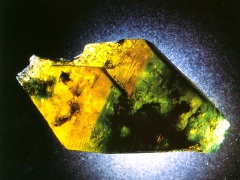 |
 |
||
| 濃緑のルース 0.57ct
4.9mm Faceted dark-green stone |
黄緑色の天藍石とカボション(5.8ct)とルース(4ct) Cabochon(5.8ct) and faceted stone(4ct) with yellow-green lazulite ウィーン自然史博物館(Natural History Museum, Vienna) |
2色の結晶 4.8cm Yellow-green bi-color crystal Obodda Collection |
| Laila Mountain, near Gilgit, Skardu, Pakistan | ||
図らずもF.ポー博士が予期したまさに1994年の8月、ヒマラヤ山脈で宝石質の大きな天藍石結晶がイタリアの鉱物商の調査隊によって発見されていました。
ただし、従来のアウインのような輝くような青ではなく、濃緑-黄緑のかつて天藍石にはなかった色合いです。
場所はパキスタンのギルギットに近い Dassu からハラモシュ峠 (標高4800m) への途上に聳えるライラ山 (6985m) の中腹、標高 4000m のライラ・キャンプと呼ばれる地点です。
キャンプと呼ばれるのは、急峻なライラ山腹で探検隊の一行がようやくキャンプを張れた唯一の平坦な場所だったからとのこと。
キャンプの周囲は柘榴石や磁鉄鉱を含む変成岩に覆われていて、天藍石はキャンプからは少し離れた場所で発見されました。
魅力的な色合いの天藍石ではありますが、しかし行くだけでも大変な場所ですから、今後大量に採れるとは到底考えられません。
In August, 1994, the very year, Dr. Frederick Pough predicted the possibility of gemmy lazulite find in Himalaya, Italian gem serach party encountered that gemmy lazulite crystal in the Laila Peak, Karakoram Range, near, Gilgit, Pakistan. The color of lazulite from Pakistan is however, not haüyn-like blue but dark green to yellowish green.
The area, surrounded entirely of metamorphic rocks was named Laila Camp at about 4000m of altitude because it was the only flat land on which it was possible for the party to camp. During one full day of exploration, they found garnet, magnesite and down-stream on the glacier, quite a few veins of white marble.
| Top | Gemhall |